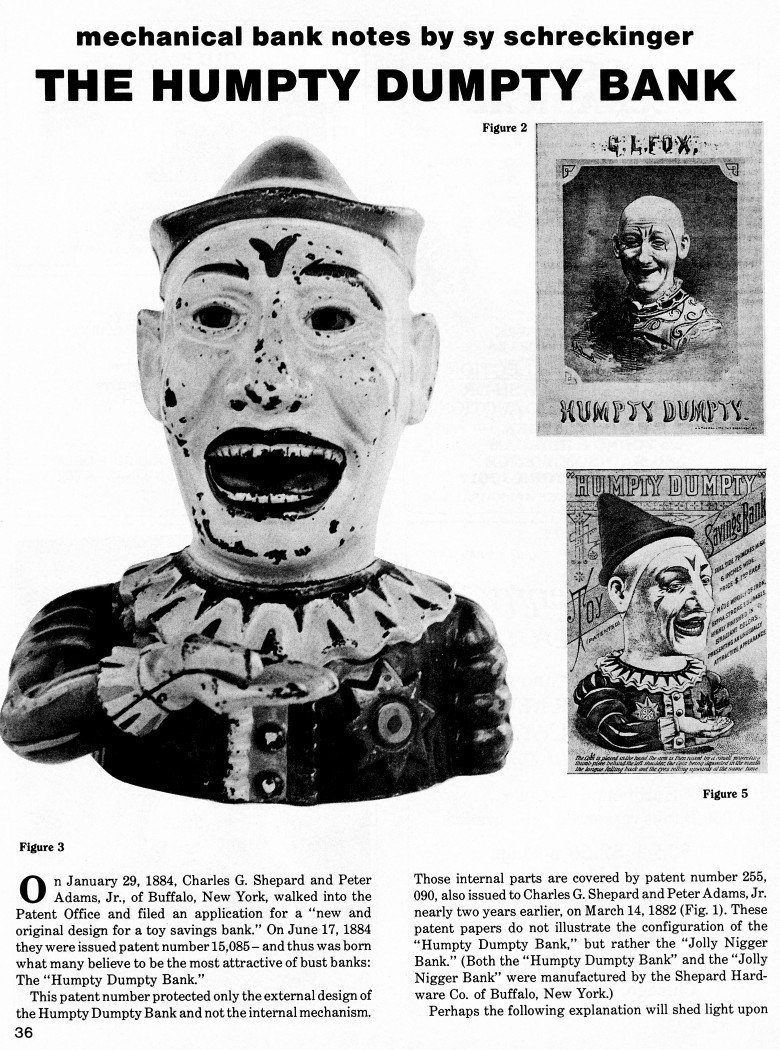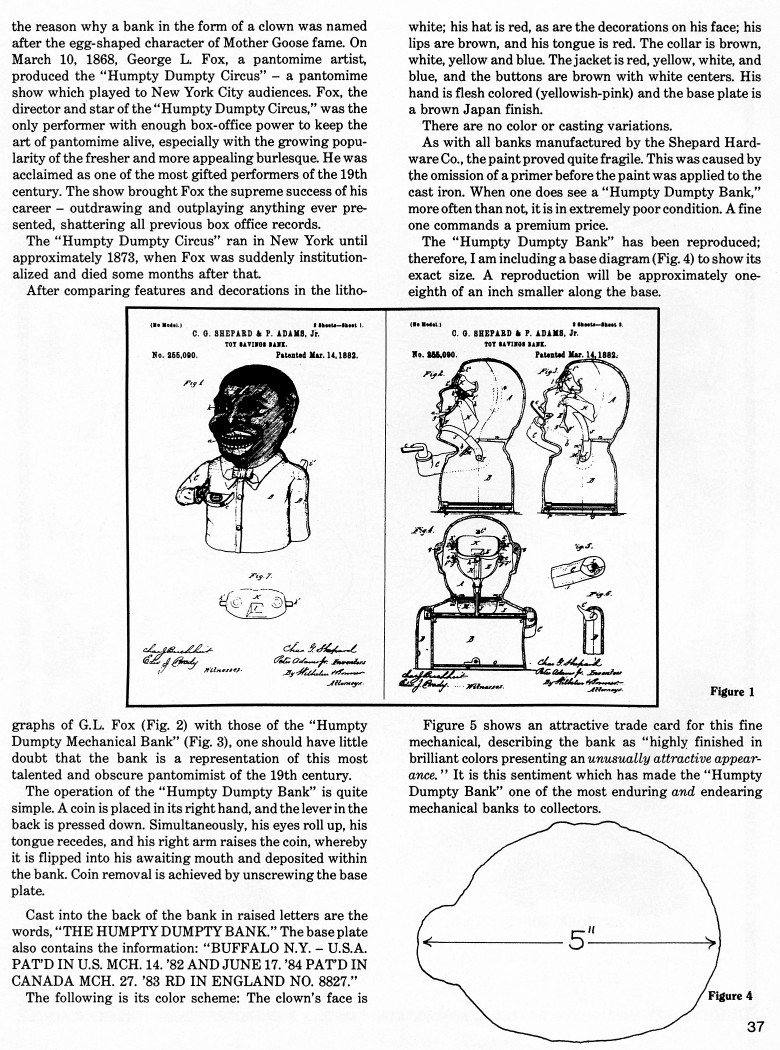|
The Humpty Dumpty Bank
by Sy Schreckinger – ANTIQUE TOY WORLD Magazine – July, 1984
On
January 29, 1884, Charles G. Shepard and Peter Adams, Jr., of Buffalo, New
York, walked into the Patent Office and filed an application for a "new
and original design for a toy savings bank." On June 17, 1884 they were
issued patent number
15,085 – and thus was born what many believe to be the
most attractive of bust banks: The "Humpty Dumpty Bank."
This patent number protected only the external design of the Humpty
Dumpty Bank and not the internal mechanism. Those internal parts are
covered by patent number
255,090, also issued to Charles G. Shepard and
Peter Adams, Jr. nearly two years earlier, on March 14, 1882 (Fig. 1).
These patent papers do not illustrate the configuration of the "Humpty Dumpty Bank," but rather the "Jolly Nigger Bank." (Both the "Humpty Dumpty
Bank" and the "Jolly Nigger Bank" were manufactured by the Shepard
Hardware Co. of Buffalo, New York.)
Perhaps the following explanation will shed light upon the reason why
a bank in the form of a clown was named after the egg-shaped character of
Mother Goose fame. On March 10, 1868, George L. Fox, a pantomime artist,
produced the "Humpty Dumpty Circus" – a pantomime show which played to New
York City audiences. Fox, the director and star of the "Humpty Dumpty
Circus," was the only performer with enough box-office power to keep the
art of pantomime alive, especially with the growing popularity of the
fresher and more appealing burlesque. He was acclaimed as one of the most
gifted performers of the 19th century. The show brought Fox the supreme
success of his career – outdrawing and outplaying anything ever presented,
shattering all previous box office records.
The "Humpty Dumpty Circus" ran in New York until
approximately 1873, when Fox was suddenly institutionalized and died some
months after that.
After comparing features and decorations in the
lithographs of G.L. Fox (Fig. 2) with those of the "Humpty Dumpty
Mechanical Bank" (Fig. 3), one should have little doubt that the bank is a
representation of this most talented and obscure pantomimist of the 19th
century.
The operation of the "Humpty Dumpty Bank" is quite simple. A coin is
placed in its right hand, and the lever in the back is pressed down.
Simultaneously, his eyes roll up, his tongue recedes, and his right arm
raises the coin, whereby it is flipped into his awaiting mouth and
deposited within the bank. Coin removal is achieved by unscrewing the base
plate.
Cast into the back of the bank in raised letters are the words, "THE
HUMPTY DUMPTY BANK." The base plate also contains the information:
"BUFFALO N.Y. – U.S.A. PAT'D IN U.S. MCH. 14.'82 AND JUNE 17.'84 PAT'D IN
CANADA MCH. 27. '83 RD IN ENGLAND NO. 8827."
The following is its color scheme: The clown's face is white; his hat is
red, as are the decorations on his face; his lips are brown, and his
tongue is red. The collar is brown, white, yellow and blue. The jacket is
red, yellow, white, and blue, and the buttons are brown with white
centers. His hand is flesh colored (yellowish-pink) and the base plate is
a brown Japan finish.
There are no color or casting variations.
As with all banks manufactured by the Shepard Hardware Co., the paint
proved quite fragile. This was caused by the omission of a primer before
the paint was applied to the cast iron. When one does see a "Humpty Dumpty
Bank," more often than not, it is in extremely poor condition. A fine one
commands a premium price.
The "Humpty Dumpty Bank" has been reproduced; therefore, I am
including a base diagram (Fig. 4) to show its exact size. A reproduction
will be approximately one-eighth of an inch smaller along the base.
Figure 5 shows an attractive trade card for this fine mechanical,
describing the bank as "highly finished in brilliant colors presenting an
unusually attractive appearance." It is this sentiment which has made the
"Humpty Dumpty Bank" one of the most enduring and endearing mechanical
banks to collectors.
|


